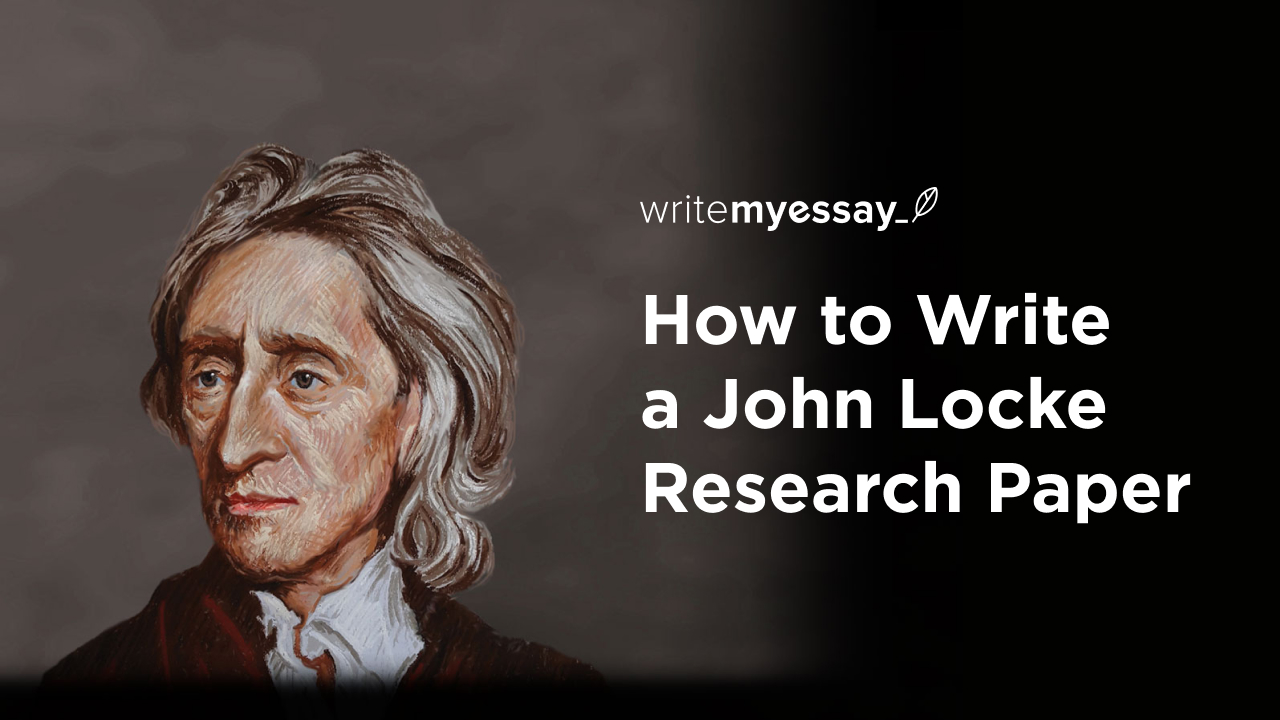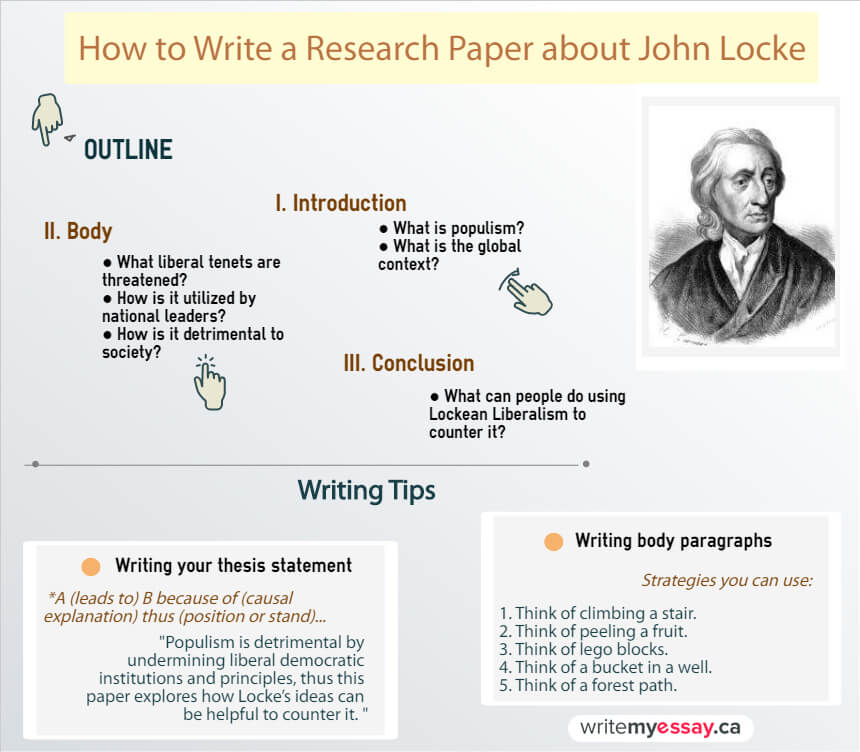
How to Write a John Locke Research Paper

Table of Contents
John Locke Research Paper

- How to start
- Example of the outline
- How to write the introduction
- Example of the introduction
- How to write the thesis statement
- Example of the thesis statement
- How to write body paragraphs
- Example of the 1st body paragraph
- Example of the 2nd body paragraph
- Example of the 3rd body paragraph
- How to conclude the research paper
- Example of the conclusion
- Research paper revision
How to start
Whether it is a student or an academic, one always has to start knowing the subject matter of any research. Knowing means coming up with a Review of Related Literature (RRL), no matter what academic field. It allows one to see what has been discussed already and the methods or cases employed by previous scholars. For example, a student planning to conduct a research on Locke could take a look at publication and dissertations discussing his ideas. That way, the writer will get an idea of what is “missing” in the literature so to complete it. If the author has a topic in mind already, one helpful tip is to access any online journal and type in the keywords of the topic. That will reveal the kind and depth of research done and give the researcher an idea of what he/she could contribute further. That helps in ensuring that one’s research is both timely and relevant.
Example of the outline
An outline is helpful to serve as a guide for writing your paper sucessfully. One benefits from it so the writing process is efficient and orderly. Moreover, the result will also be advantageous for the reader if the composition is coherent.
I. INTRODUCTION
- What is populism?
- What is the global context?
II. BODY PARAGRAPHS
- What liberal tenets are threatened?
- How is it utilized by national leaders?
- How is it detrimental to society?
III. CONCLUSION
- What can people do using Lockean Liberalism to counter it?
How to write the introduction
Because the introduction is the first part that readers will encounter, one should write it with considerable thought. Here are the following ways of how it could be done.
- Catch attention or give an entry point. The writer can use a short but relevant quotation or anecdote, for example. In this way, the opening will give familiarity and connect with the readers instantly.
- Frame issue outright. The reader should already see what your research is mainly about and the thesis or argument that it will pursue.
- Start with the end in mind. This helps the author write in a way that is both smooth and coherent. The outline made beforehand provides a direction so that readers and the writer alike are not lost.
- Set definitions. The introduction is a good place to define your concepts as used in the research. Using key terms will also orient your readers immediately to your topic.
- Provide relevance. A simple yet critical point. Out of all other things to read out there, why is this research worth reading?
Example of the introduction
“The specter of populism is haunting the world, looming over nations and societies across regions. According to Mudde and Kaltwasser (2017), it is ‘as an ideology that divides society into two antagonistic camps, the “pure people” versus the “corrupt elite,” and that privileges the general will of the people above all else.’ In the United States, the election of Trump brought about political conflicts and altercations centered on racial divisions, problematic immigration reforms and isolationist economic policies.
How to write the thesis statement
The thesis statement must be specific, concise and explanatory. One way is to show the direction of causality (A → B) and clarify the underlying relationship. One should avoid putting too many concepts and vague terms. However, it should be broad enough to indicate a stand or position.
- A ‘leads to’ B because of(causal explanation) thus (position or stand)…
Example of the thesis statement
Populism is detrimental by undermining liberal democratic institutions and principles, thus this paper explores how Locke’s ideas can be helpful to counter it.
How to write body paragraphs
- Think of climbing a stair. The transition between ideas in each paragraph is related and relevant. Like attaining levels, main points should be connected towards the thesis statement.
- Think of peeling a fruit. The body must elaborate by ‘threshing out’ the important ideas provided in the previous paragraphs. Terms are explained and defined succinctly.
- Think of Lego blocks. The writer builds the whole research from the base idea. Claims are supported and strengthened using facts, data, statistics, and evidence.
- Think of a bucket in a well. This a great tip in the writing process. The author should “lower the bucket” slowly not surprising the readers but letting them acclimatize and absorb the information presented.
- Think of a forest path. Since it is new and unfamiliar to the reader, the body must serve as a path from the introduction up to the conclusion. It will help to provide signposts i.e. subsections for each idea to be discussed.
Example of the 1st body paragraph
Populism is a very slippery concept in the same manner like liberalism. Both are terms that been used so numerous times that their meanings quickly escape one’s grasp. This paper will first seek to clarify some key notions about them.
Example of the 2nd body paragraph
The current global order is neoliberalism. It is evident how free market ideals are valued throughout nations and democracy has continuously become the model for every state. Globalization too is the current buzzword and no corner of the world can arguably escape its reach.
Example of the 3rd body paragraph
Populism threatens this democratic order and it perpetuates despotism and authoritarian tendencies. These are mortal enemies of the liberal creed. As will be illustrated later, economic complications that could spread to other regions are likely risks as well. This is because populist leaders tend to be isolationist.
How to conclude the research paper
To conclude your paper, the following reminders could be observed.
- Synthesize instead of just summarizing. The author must illustrate how ideas are related as they lead up to the conclusion.
- Provoke to give a lasting impression. One could give a quote, an extraordinary insight or evoke an image that relates the research to real-world implication.
- Give a call to action. Avoid being pretentious or needless appeal to emotions. Instead, challenge the readers by emphasizing what they can do and contribute.
- Recommend. Apart from acknowledging limitations and the lapses in the scholarship, one could show further leads for future research.
- Own the work. The research must culminate in convincing the reader of one’s thesis and not diminish its credibility. Avoid being unsure or apologetic like saying “this is just my view” or “I may be wrong.”
Example of the conclusion
“We should always be vigilant and be active participants in society. For in a silent and complicit majority arises a strongman leader who deceives the masses into fighting a vague and non-existent enemy. Let us be reminded by Locke’s wisdom, “It is one thing to show a man that he is in error, and another to put him in possession of the truth.” So unless we speak truth to power, populist executives will continue to dominate and harm our liberties.”
Research paper revision
The following are simple yet effective revision tips that anyone can use.
- Set a personal deadline before the actual one. This gives the student or a professional leeway to adjust and edit.
- Schedule a break before revising to rest one’s eyes and mind. Being too absorbed and accustomed to writing can make one miss out common errors.
- Take down insights and note where possible inaccuracies can occur while writing. This allows one to quickly return to parts that need clarification and refining.


